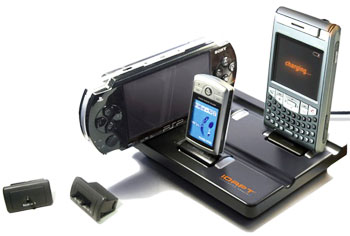
Google launched its Chrome OS, which is really a copy of several products already on the market and an interesting recreation of the thin client concept that Sun and Oracle came up with over a decade ago. You could argue, however, that most successful products, like the iPod and iPhone, are simply better copies of what came before. Really, nobody cares that much — consumers only care about whether a new offering will make their lives better. The Google Chrome OS goes directly to a primary need that mainstream PC users have had unmet since the beginning: an appliance experience.
While I’m not convinced that Google is approaching this market correctly — primarily because it lacks focus and has a conflicting product with Android — the opportunities and threats this product represents are very real. Still, this week I’ll point to the winners and losers if — and “IF” — is a big word, the Google Chrome OS becomes dominant.
I’ll close with my product of the week, something I saw at IFA a few months ago and ordered for myself and liked so much I got an additional one for my wife.
Winners: Think Non-PC
The big winners are the companies that are empowered to drive into markets they currently don’t play in, or are trivialized in. The Google Chrome OS, (“COS,” because I don’t want to have to keep typing “Google Chrome OS”), is disruptive. As OnLive does for console gaming, the COS shifts load and complexity from the desktop to the Internet using, but not necessarily requiring, a cloud model.
The first group that would be dancing in the streets are people like Marvell, Nvidia, and Qualcomm, because these companies are backing ARM into ever more capable devices that could be more than adequate for clients that are increasingly streaming video or relying on hosted resources to do their computing.
The second group is the wireless carriers and those that sell wireless services in airlines, because this platform requires an always-on connection, which is something that hasn’t penetrated well into the PC space yet. The Chrome OS puts these wireless service providers in the middle of the solution and likely will place a massive amount of funding under WiMax and LTE, aka “4G” wireless networking.
The third group is developers already doing well in the various app store cellphone markets. This will explode the app store concept, and people who know how to build and sell compelling applications will likely gain massive new customer bases. I would include those that have been successful in building related service models as well.
This takes us to the 4G wireless networking equipment makers who should increasingly see large sums of money flowing in their direction as the service providers rush to get ready for this opportunity. This will be a rather massive buildout and, at least in the U.S., could benefit from the networking-focused stimulus spending. Given that the Obama administration appears to favor this solution, this outcome seems likely.
Finally, companies that can provide high-capacity server resources at very aggressive prices should benefit as well. While this may commoditize rack-mounted servers, the companies that provide related services should get substantial growth out of this effort. Since Google is one of the largest of this class of firm, this showcases how strategic this effort is for it. The COS is likely more strategic than Android is, which is an interesting thought.
Losers: Those Tied to the PC Status Quo
If this were a normal market where the challenging firm or firms largely lived in the low-cost, high-volume space, Apple would be on the shortlist of losers. However, Apple is relatively protected because it exists at the high end of the market, which will probably move last and has a customer base that is considered the most loyal in the industry.
This puts Microsoft on the leading edge of exposure, but it gives it several years to respond. No matter how you look at it, even if Apple and Microsoft respond, they will have to sacrifice desktop revenue to do so, and neither will move aggressively to do that.
Intel and AMD drive the current PC platform, but the COS initiative favors low-cost, low-performance desktop platforms. This means that even though they will continue to sell processors, those processors will increasingly come from the value bins — not the higher-margin performance bins.
Even on the server side, this movement favors Google’s hardware model of massive numbers of low-cost servers or virtual machines — more IO than processing power. Both firms will likely have to shift their priorities for future products sharply. Server growth, however, is expected to be significant.
PC OEMs already are facing thin margins and excessive competition, and the COS would increasingly add cellphone companies to this mix. The COS also will tend to favor hardware in the sub US$300 category, putting additional pressure on both top-line and bottom-line performance. This would, if successful, effectively turn PC manufacturers into white goods companies, and some of the existing white goods companies may decide to re-enter this segment as a result.
Cable and wired telephony companies that don’t have strong wireless positions will increasingly find themselves made obsolete as the COS drives people away from wired providers to wireless ones for much of their data consumption. The speed of this will likely depend on economic pressures that drive strapped consumers to eliminate redundant services; better economic conditions would slow this trend substantially.
Wild Cards
There are a few areas that I think could go either way. Graphics, for instance, will take a massive hit on the client side, but this technology is relatively unknown on the server side, and it could explode there. The gain could actually exceed the loss because this technology is contained in a relatively small number of vendors, which potentially could allow for stronger-than-normal margins.
Existing private cloud vendors could be replaced by lower-cost alternatives for public cloud offerings — but industry doesn’t like the public cloud model, and Google will likely license its back end to enterprises. This could lead to partnerships with companies like IBM, HP and EMC/Cisco/VMware, which could lead to substantial additional opportunity in what will be an increasingly lucrative enterprise private cloud space.
What happens to existing thin-client companies will depend on how they approach this opportunity. If they treat it like a competitor and it is successful, they get displaced, if they embrace it with their more-advanced and mature tools, they could end up more successful than they have ever been. It would seem obvious that they should do the latter, but companies facing change more often protect their turf than embrace a change like this.
Wrapping Up: Opportunity and Risk
Google is thinly spread and has shown an increasing inability to focus, which does make the near-term success of the COS somewhat unlikely. However, the market has wanted an appliance solution for the PC for decades, and one will eventually emerge.
When it does, it will change the PC market as we know it, and it will be interesting to see who is still standing after the fog clears. My sense is that it will be those that have the vision to anticipate where this market is going and get there first. Here’s hoping it is the company you work for.
Product of the Week: Idapt Super Charger

Given the time of year, I’m constantly thinking of unusual gifts that solve problems and that folks won’t get several of. While I was at IFA, I picked up a brochure on the Idapt Innovative Adapter (charger) and figured I’d order one. I have been nothing but pleased. My wife liked it so much, she had me buy her one. This is because our bathroom counter had become a rat’s nest of charger wires, as both of tried to keep our phones, wireless headsets and music players charged (she has several iPods and I’m still using a Slacker G2).

You can pick the power adapters for most phones and other devices (it covers most of the iPods but not yet the Zune), and it has been working like a champ so far.
The Idapt got rid of the cables, and, OMG, the marble underneath was actually very attractive once the crap was removed from the top of it. Right now you can only order it from Europe, and it takes a couple of weeks to arrive and costs, with shipping, around $100, I used PayPal.
I think this is a great innovative product and actually bought two of them myself, so the Idapt charger is my product of the week.
Rob Enderle is a TechNewsWorld columnist and the principal analyst for the Enderle Group, a consultancy that focuses on personal technology products and trends.






















































Hi Ron, an interesting article. You’re right that, while Google are heading in the right direction here, there is a certain lack of focus with Chrome OS. Our product, the litl webbook, running our cloud-based OS, is already on the market (from litl.com) and is tightly designed to be *the* web appliance for use around the home. We control hardware, software and our servers so we can create an integrated, easy experience.
Chrome OS has also been accused by another commentator of not creating a "new organizing principle for the web" – ie it appears to be basically the Chrome browser and not re-engineered for any particular use case.
By contrast we at litl threw out the conventional browser interface in order to create something new and different that pares things down to just what is needed to use our device. We want to get rid of the unneeded stuff that hinders your enjoyment of the web.
We created our own apps called litl channels that essentially package web streams, webapps or content into interfaces that are logically consistent with our unique UI. We will be releasing our SDK for litl channels in due course so that a community of apps developers can get involved in building channels for litl. Currently we are also working with high profile partners to develop special channels for litl that will bring exciting content to our device.
General purpose OSs and generic computers will be with us for a while perhaps – but for many people these and all the hassle that goes with them just aren’t needed any more. Google has got that much right.